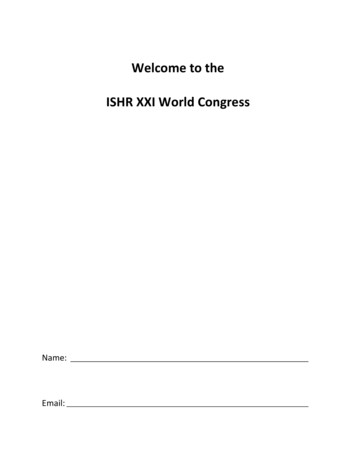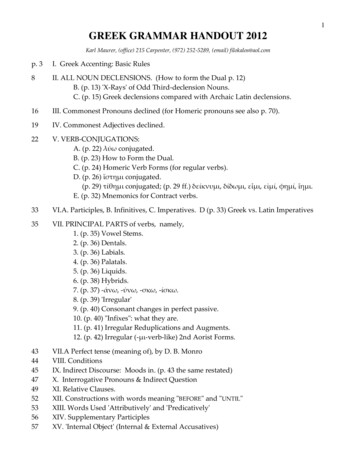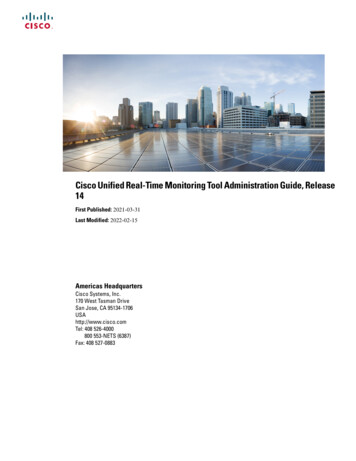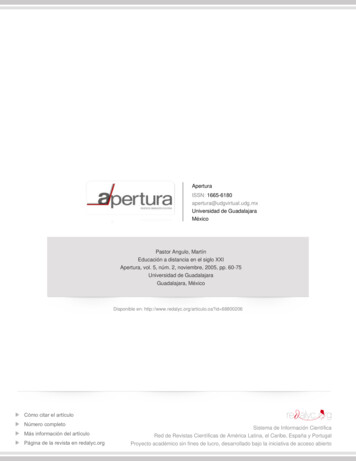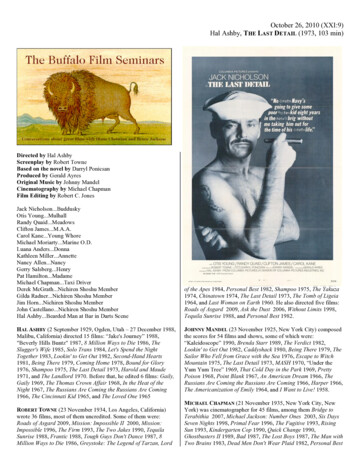
Transcription
October 26, 2010 (XXI:9)Hal Ashby, THE LAST DETAIL (1973, 103 min)Directed by Hal AshbyScreenplay by Robert TowneBased on the novel by Darryl PonicsanProduced by Gerald AyresOriginal Music by Johnny MandelCinematography by Michael ChapmanFilm Editing by Robert C. JonesJack Nicholson.BudduskyOtis Young.MulhallRandy Quaid.MeadowsClifton James.M.A.A.Carol Kane.Young WhoreMichael Moriarty.Marine O.D.Luana Anders.DonnaKathleen Miller.AnnetteNancy Allen.NancyGerry Salsberg.HenryPat Hamilton.MadameMichael Chapman.Taxi DriverDerek McGrath.Nichiren Shoshu MemberGilda Radner.Nichiren Shoshu MemberJim Horn.Nichiren Shoshu MemberJohn Castellano.Nichiren Shoshu MemberHal Ashby.Bearded Man at Bar in Darts SceneHAL ASHBY (2 September 1929, Ogden, Utah – 27 December 1988,Malibu, California) directed 15 films: “Jake's Journey” 1988,"Beverly Hills Buntz" 1987, 8 Million Ways to Die 1986, TheSlugger's Wife 1985, Solo Trans 1984, Let's Spend the NightTogether 1983, Lookin' to Get Out 1982, Second-Hand Hearts1981, Being There 1979, Coming Home 1978, Bound for Glory1976, Shampoo 1975, The Last Detail 1973, Harold and Maude1971, and The Landlord 1970. Before that, he edited 6 films: Gaily,Gaily 1969, The Thomas Crown Affair 1968, In the Heat of theNight 1967, The Russians Are Coming the Russians Are Coming1966, The Cincinnati Kid 1965, and The Loved One 1965ROBERT TOWNE (23 November 1934, Los Angeles, California)wrote 36 films, most of them uncredited. Some of them were:Roads of Asgard 2009, Mission: Impossible II 2000, Mission:Impossible 1996, The Firm 1993, The Two Jakes 1990, TequilaSunrise 1988, Frantic 1988, Tough Guys Don't Dance 1987, 8Million Ways to Die 1986, Greystoke: The Legend of Tarzan, Lordof the Apes 1984, Personal Best 1982, Shampoo 1975, The Yakuza1974, Chinatown 1974, The Last Detail 1973, The Tomb of Ligeia1964, and Last Woman on Earth 1960. He also directed five films:Roads of Asgard 2009, Ask the Dust 2006, Without Limits 1998,Tequila Sunrise 1988, and Personal Best 1982.JOHNNY MANDEL (23 November 1925, New York City) composedthe scores for 54 films and shows, some of which were:“Kaleidoscope” 1990, Brenda Starr 1989, The Verdict 1982,Lookin' to Get Out 1982, Caddyshack 1980, Being There 1979, TheSailor Who Fell from Grace with the Sea 1976, Escape to WitchMountain 1975, The Last Detail 1973, MASH 1970, “Under theYum Yum Tree” 1969, That Cold Day in the Park 1969, PrettyPoison 1968, Point Blank 1967, An American Dream 1966, TheRussians Are Coming the Russians Are Coming 1966, Harper 1966,The Americanization of Emily 1964, and I Want to Live! 1958.MICHAEL CHAPMAN (21 November 1935, New York City, NewYork) was cinematographer for 45 films, among them Bridge toTerabithia 2007, Michael Jackson: Number Ones 2003, Six DaysSeven Nights 1998, Primal Fear 1996, The Fugitive 1993, RisingSun 1993, Kindergarten Cop 1990, Quick Change 1990,Ghostbusters II 1989, Bad 1987, The Lost Boys 1987, The Man withTwo Brains 1983, Dead Men Don't Wear Plaid 1982, Personal Best
Ashby—THE LAST DETAIL —21982, Raging Bull 1980, The Wanderers 1979, Hardcore 1979,Invasion of the Body Snatchers 1978, The Last Waltz 1978, Fingers1978, The Next Man 1976, The Front 1976, Taxi Driver 1976,TheWhite Dawn 1974, and The Last Detail 1973.ROBERT C. JONES (8 March 1937) has edited 32 films, includingUnconditional Love 2002, Bulworth 1998, City Hall 1996, TheBabe 1992, Lookin' to Get Out 1982, Heaven Can Wait 1978,Bound for Glory 1976, Shampoo 1975, The Last Detail 1973, Manof La Mancha 1972, The New Centurions 1972, Cisco Pike 1972,Love Story 1970, Paint Your Wagon 1969, I Love You, Alice B.Toklas! 1968, Guess Who's Coming to Dinner 1967, Tobruk 1967,Ship of Fools 1965, It's a Mad Mad Mad Mad World 1963, and AChild Is Waiting 1963.JACK NICHOLSON (22 April 1937, Neptune, New Jersey) hasappeared in 75 films and tv series, some of which were How DoYou Know (2010), The Bucket List (2007), The Departed (2006),Something's Gotta Give (2003), Anger Management (2003), AboutSchmidt (2002), The Pledge (2001), As Good as It Gets (1997),Mars Attacks! (1996), The Evening Star (1996), Blood and Wine(1996), The Crossing Guard (1995), Wolf (1994), Hoffa (1992), AFew Good Men (1992), Man Trouble (1992), The Two Jakes(1990), Batman (1989), Ironweed (1987), Broadcast News (1987),The Witches of Eastwick (1987), Heartburn (1986), Elephant'sChild (1986) (TV), Prizzi's Honor (1985), Terms of Endearment(1983), The Border (1982), Reds (1981), Ragtime (1981), ThePostman Always Rings Twice (1981), The Shining (1980), Goin'South (1978), The Last Tycoon (1976), The Missouri Breaks (1976),One Flew Over the Cuckoo's Nest (1975), The Fortune (1975),Tommy (1975), Professione: reporter/ The Passenger (1975),Chinatown (1974), The Last Detail (1973), The King of MarvinGardens (1972), A Safe Place (1971), Carnal Knowledge (1971),Five Easy Pieces (1970), On a Clear Day You Can See Forever(1970), The Rebel Rousers (1970), Easy Rider (1969), Head (1968),Psych-Out (1968), Hells Angels on Wheels (1967), The Shooting(1967), "Dr. Kildare" (4 episodes, 1966), Ride in the Whirlwind(1965), Ensign Pulver (1964), The Terror (1963), The Raven(1963), Studs Lonigan (1960), The Wild Ride (1960), The LittleShop of Horrors (1960), Too Soon to Love (1960), and The CryBaby Killer (1958).OTIS YOUNG (4 July 1932, Providence, Rhode Island—11 October2001, Los Angeles, California) was in 26 films and shows,including After Image 2001, "Hill Street Blues" 1985, TheHollywood Knights 1980, "Palmerstown, U.S.A." 1980, TheCapture of Bigfoot 1979, “Twin Detectives” 1976, "Cannon" 1976,Survival 1976, "Columbo" 1975, The Last Detail 1973, The Clones1973, "McCloud" 1972, "The Outcasts" 1968-1969, Me and MyBrother 1969, "The F.B.I." 1968, “Valley of Mystery” 1967,"Daniel Boone" 1967, and Murder in Mississippi 1965.RANDY QUAID (1 October 1950, Houston, Texas) has been in 115films. Some of them are: Balls Out: Gary the Tennis Coach 2009,Real Time 2008, Goya's Ghosts 2006, Brokeback Mountain 2005,Grind 2003, Black Cadillac 2003, Not Another Teen Movie 2001,Hard Rain 1998, Kingpin 1996, Independence Day 1996, Curse ofthe Starving Class 1994, “Frankenstein” 1992, "Saturday NightLive" 1985-1991, Caddyshack II 1988, Vacation 1983, “Of Miceand Men” 1981, The Long Riders 1980, Foxes 1980, “The LastRide of the Dalton Gang” 1979, Midnight Express 1978, TheChoirboys 1977, Bound for Glory 1976, The Missouri Breaks 1976,The Apprenticeship of Duddy Kravitz 1974, The Last Detail 1973,Paper Moon 1973, What's Up, Doc? 1972, The Last Picture Show1971, and Targets 1968.CAROL KANE (18 June 1952, Cleveland, Ohio) has appeared in 124films and shows, including Should've Been Romeo 2011, MyGirlfriend's Boyfriend 2010, The Bounty Hunter 2010, Kung FuPanda: Secrets of the Furious Five 2008, Love in the Time ofMoney 2002, Trees Lounge 1996, The Pallbearer 1996, TheCrazysitter 1995, "Seinfeld" 1994, Addams Family Values 1993,"Tales from the Crypt" 1990, Joe Versus the Volcano 1990, TheLemon Sisters 1989, Scrooged 1988, The Princess Bride 1987,Ishtar 1987, Jumpin' Jack Flash 1986, Racing with the Moon 1984,When a Stranger Calls 1979, The Muppet Movie 1979, The World'sGreatest Lover 1977, Valentino 1977, Annie Hall 1977, Harry andWalter Go to New York 1976, Hester Street 1975, Dog DayAfternoon 1975, The Last Detail 1973, Wedding in White 1972,Carnal Knowledge 1971, and Desperate Characters 1971.MICHAEL MORIARTY (5 April 1941, Detroit, Michigan) has actedin 85 films and shows, some of which are The Yellow Wallpaper2010, Hitler Meets Christ 2007, “Mob Princess” 2003, SwimmingUpstream 2002, Along Came a Spider 2001, "The Outer Limits"2000, "Touched by an Angel" 1998, Shiloh 1996, “Children of theDust” 1995, "Law & Order" 1990-1994, "The Twilight Zone" 1988,It's Alive III: Island of the Alive 1987, The Hanoi Hilton 1987, DarkTower 1987, Pale Rider 1985, Q 1982, Who'll Stop the Rain 1978,Report to the Commissioner 1975, “The Glass Menagerie” 1973,The Last Detail 1973, Bang the Drum Slowly 1973, Hickey & Boggs1972, and My Old Man's Place 1971.NANCY ALLEN (24 June 1950, New York City) has appeared in 42films and tv shows, some of which are My Apocalypse 2008, "Law& Order: Special Victims Unit" 2003, Children of the Corn 666:Isaac's Return 1999, Against the Law 1997, "Touched by an Angel"1994, RoboCop 3 1993, RoboCop 2 1990, Poltergeist III 1988,RoboCop 1987, The Philadelphia Experiment 1984, The BuddySystem 1984, "Faerie Tale Theatre" 1984, Blow Out 1981, Dressedto Kill 1980, I Wanna Hold Your Hand 1978, Carrie 1976, ForcedEntry 1975, The Last Detail 1973, and Money in My Pocket 1962.Hal Ashby from World Film Directors, V. II. Ed. JohnWakeman. H.W. Wilson Company, NY, 1988The American director was born in Ogden, Utah, where his fatherran a dairy. His date of birth is given variously as 1930, 1932, and1936. Ashby’s childhood was troubled and insecure. Almost everyone in Ogden except his own family were Mormons, and his parentswere not happy together. Ashby was confused and disturbed at theage of five or six by their divorce, and traumatized by his father’ssuicide seven years later. He was surly at home and difficult atschool, dropping out in his senior year.According to Paul Fritzler in Close-Up: The ContemporaryDirector, Ashby “drifted from job to job and woman to woman. Hewas married and divorced twice by the time he was twenty-one. In1953 he hitchhiked to Los Angeles. After he tried about fifty orsixty jobs—’You name it; I did it’—he ended up as a Multilithoperator at the old Republic Pictures.”One day, “running off ninety or so copies of some page14,” it occurred to him that he wanted to make films himself.Everyone assured him that “the best school for a director is in thecutting room” and after much persistence, he was taken on as anapprentice cutter. He believes that his advisers were correct—that
Ashby—THE LAST DETAIL —3“when film comes into a cutting room, it holds all the work andefforts of everyone involved up to that point: the staging, writing,acting photography, sets, lighting, and sound. It is all there to bestudied again and again and again, until you really know why it’sgood, or why it isn’t.”What Ashby found hardest was the union rule that anapprenticeship lasts eight years, an ordeal byboredom and frustration that he believes hasthrottled a great deal of creative editorialtalent. His first assignment as as fourthapprentice editor on William Wyler’s The BigCountry (1958). The chief editor was RobertSwink, who became Ashby‘s mentor. Swinktaught him to “forget about the script, throwaway all the so-called rules, and don’t try tosecond-guess the director. Just look at the filmand let it guide you .Don’t be afraid of thefilm. You can cut it twenty-six different ways and, if none of theseworks, you can always put it back into daily form, and start over.”Ashby worked with Swink on his next four films and wasallowed to edit a few sequences of the last of these, The Best Man(1964). He moved up to assistant editor on The Greatest Story EverTold (1965) and to chief editor on Tony Richardson’s The LovedOne (1965); he had completed first cut when Richardsonunexpectedly left to complete the editing in London. A period ofdepression and unemployment followed, and then Ashby wasintroduced to the director Norman Jewison, who needed an editorfor The Cincinnati Kid (1965). He and Jewison got alongexceptionally well, and the director used him again on The RussiansAre Coming, The Russians Are Coming (1966), In the Heat of theNight (1967), and The Thomas Crown Affair (1968). Ashby saysthat Jewison “let me select and cut his films as I felt it. It was aneditor’s dream and, in the end, it brought me two Academynominations and one Oscar for In the Heat of the Night.”Jewison made Ashby his associate producer—all-purposeassistant—on Gaily, Gaily (1969). The director then becameinterested in Bill Gunn’s script The Landlord. Finding that he couldnot fit it into his schedule,he offered to produce it if Ashby wouldcare to direct. When Ashby had finished “doing a dance around theoffice,” they settled down to persuade the Mirisch Brothers andUnited Artists to gamble 2 million on an untried director.Reasonably confident about the technical aspects of histask, Ashby became increasingly uncertain of his ability to handleactors. As the first day of shooting loomed after a week ofrehearsals, he worked (and scared) himself “into a state of walkingpneumonia.” For the first three days he was “just gaping all day andpointing a lot.” Finding that he could nevertheless communicatewith his cast, “he enjoyed it from that point on.”The Landlord (1970) was based on a novel by KristinHunter. It is a comedy about a rich white man, Elgar Enders (BeauBridges), who at the age of twenty-one “runs away” from his LongIsland mansion and buys a Brooklyn tenement in the promisingghetto of Park Slope. His plan is to evict the black tenants and turnthe place into a fashionable pad for himself. The tenants, however,refuse either to move out ot pay rent, and start to lay voodoo spellson him.Before long he finds himself drawn into their lives, soviolently different from his own. There is Fanny (Diana Sands),wretchedly married to the brutish Copee (Lou Gosset), who takesrefuge in an affair with Enders; a free-school teacher (MelvinStewart) struggling to instill racial pride in his students and theblack earth mother Marge (Pearl Bailey), who undertakes Enders’education in street wisdom. Marki Bey plays Lanie, a mulatto discodancer who bridges the film’s two worlds and provides Enders withthe possibility of a happy ending. Having rejected his own socialgroup,Enders is rejected in turn by the ghetto, and moves out to livewith Lanie and his boy by Fanny.Compared to these passionate, hurt, and sometimesdangerous people, Enders’ family arecaricatures out of a screwball comedy. LeeGrant is splendid as his imbecile mother,whose struggle for racial equality is limited toviewing Guess Who’s Coming to Dinner? Hissister, Susan Anspach, is a spaced-out debabout to marry into napalm. To underline thecontrast between Enders’ two worlds, Ashbyhad his cinematographer Gordon Willisunderexpose the Brooklyn scenes and overexpose the Long Island ones, making theghetto seem darker and more richly colored than reality, life in themansion brighter and frothier.These extreme contrasts of tone and image threaten to pullthe film apart, and its cohesion is further undermined, as PaulFritzler says, by “the flashy editing, fragmented narrative, flashforwards, repeater shots, and straight-to-the-camera soliloquies.”Nevertheless, for Fritzler, “Ashby made it all work in a film that isboth hilarious and haunting.” A few reviewers were irritated by this“stylistic slickness,” attributed by one to the influence of NormanJewison, but most shared Fritzer’s enthusiasm, praising theperformances the tyro director had drawn from his players, andcalling this “a comedy of more than usual bite and vigor.”Carl Dubliclay, writing in Film Reader (1, 1975),suggested that the main theme in all of Ashby’s films is “how do welive?—not only a simple question [but] an exhortation to examineour own lives and, in a large part, to change them.” As Dubliclaysays, this question central to The Landlord, is answered “in terms ofan individualistic choice rather than a group solution” to theproblem of race.The Landlord was too offbeat a movie to make muchimpression at the box office, but its critical reception was goodenough to bring Ashby an even less conventional script fromParamount. This was Harold and Maude, written by Colin Higginsas his thesis for a masters degree. Like Elgar Enders, Harold is apoor little rich boy with an appalling mother (Vivian Pickles). Inlate adolescence, pallid and wide-eyed, he is played by Bud Cortwith a mixture of bewilderment and defiance that reminded DavidRobinson of Harry Langdon. Since the day he was mistakenlyreported dead and wrung a flash of concern from his ice-coldmother, Harold has dedicated himself to faking more or lessspectacular suicides—setting fire to himself or hanging himselffrom the drawing room chandelier (“I suppose you think that’s veryamusing,” snaps his mother, passing through.)Harold’s other pastime is attending funerals in his privatehearse, and at one graveside he meets Maude (Ruth Gordon). She isseventy-nine, but her spirit is as free as Harold’s is stifled. Shepaint, sculpts, collects smells, saves trees from pollution, and stealscars to remind people of the vanity of possessions. Harold goes tobed with her, recovers his will to live, and plans marriage. Maudehas other ideas. On her eightieth birthday, having enjoyed asufficiency of life, she takes an overdose. Harold fakes his lastsuicide , running his car off a cliff, and walks off into the futurestrumming the banjo Maude had given him.On its release in 1971, Harold and Maude was receivedwith indifference or active distaste by the major reviewers.
Ashby—THE LAST DETAIL —4Afterwards, however, it slowly developed a cult reputation,especially among young people. It was so constantly revived in arthouses that in 1978 Seattle-based Specialty Films made new printsand booked the film around the country, and this time it was greetedas a “contemporary classic” and “a work of art.” There arenevertheless some critics who, while relishing Harold’s blackcomedy, find the sixties-type dialogue and music (by Cat Stevens)dated, and Maude’s character and philosophizing whimsical andsentimental. David Thomson wrote: “The love story is prettifiedand sanitary: there is no real sex between Bud Cort and RuthGordon. It slips away into another feeble endorsement of ‘do yourown thing,’ the politics of the weary soul-searcher, too selfish andsuperficial to deal with public causes.”In 1973 Ashby was hired by MGM to direct a film starringJack Nicholson. He walked out on that project when the studioturned down his choice of female lead, and Nichoson walked outwith him, proposing as an alternative a screen version of DarrylPonicsan’s novel The Last Detail. Columbia took the film on,Robert Towne wrote the excellent adaptation, and the movie wasshot by Michael Chapman on location, partly at a military base nearToronto.Jack Nicholson plays Bad-Ass Buddusky–a bantam,foulmouthed, Navy petty officer at a Virginia transit camp. with hisblack buddy Mule Mulhall (Otis Young), he is assigned to escortMeadows (Randy Quaid), a kleptomaniac young sailor, to the navalprison in Portsmouth, New Hampshire. Meadows has been giveneight years for pilfering forty dollars from a charity collectionbox—the charity being one dear to his CO’s wife. The escorts’ planis to deliver their prisoner as rapidly as possible in order to live it upon expenses on the way back. However. appalled at the savagery ofMeadows’ sentence and by his mooncalf innocence, they decideinstead to give him a taste of all that he’ll be missing in the brig: hisfirst drunk, his first fight, his first lay.It is, as John Coleman wrote, ”hardly a sentimentaleducation. And yet, as .conveyed by glances, gestures, silences,the cliches of ‘being a man’—below-decks style—are reanimated,sweetened, lent value.” Richard Combs pointed out that the centraldrama “opens into an elusive, symbolic play on many kinds ofhuman and specifically American, experience .Gradually, with amany-layered irony, the film reveals the trap in which the twoguards, as much as their prisoner, willingly confine themselves.Scornful of the relief and resignation they see in Meadows’unprotesting attitude (‘Secretly he’s glad.this way the worst is overalready’), they themselves have happily traded insecurity for therigid structures of the navy.”Writing in the International Film Guide (1980), DianeJacobs said that The Last Detail “is the film that made Ashby atalent to reckon with. Full of green and yellow military/motelcolours, of quiet dissolves from one grey landscape to another, oftight framing in which anything beyond the proximate seemsblurred and unreal, it is a bleak-looking film .The lives weobserve are unremittingly constricted; and the sanguineness of themartial tunes that accompany the three men on their odyssey is acounterpoint that underscores this bitter reality. Movement is adominant motif here, but the movement is away from rather thantowards freedom.” The rhythmic montage editing that Ashby usedin his first two films is here dispensed with, as Carl Dubiclay says:“The dissolve has replaced the cut, and the radical compression oftime that took place in Ashby’s editing is reduced .This shift intechnique is symptomatic of Ashby’s shift in emphasis.from issueto character. The question is still ‘how do we live,’ but Ashby nowinvestigates the characters working out this question instead ofexploring the question itself.”According to Paul Fritzler, The Last Detail’s realisticallyobscene language greatly worried the Columbia executives, whofeared that they would not be able to sell the film to television. Itmight not have been released at all if it had not scored a majorsuccess at the 1974 Cannes Film Festival, where Nicholson wasvoted the best actor. Columbia eventually distributed the picture,but with minimal promotion. It was very well received by Americancritics also, and earned Oscar nominations for its screenplay and forthe performances of Nicholson and Randy Quaid. Many consider itAshby’s best film. Skillfully edited by Jerry Ayres, it was shown in1976 on ABC-TV, the sound track “scrubbed almost clean.”Questioning the propriety of this increasingly common procedure,John J. O’ Connor wrote that the expurgated version “is not bad, butit is not the production seen by movie audiences.”After that, Ashby was signed by the producers SaulZaentsz and Michael Douglas to direct One Flew Over theCuckoo’s Nest, but resigned in a disagreement over the script. MilosForman took over the film and Ashby immediately went to work onShampoo (1976), produced for Persky-Bright Associates by WarrenBeatty, who originated the project, starred in it, and scripted it incollaboration with Robert Towne.Shampoo deals with some forty-eight hours in the life ofGeorge (Warren Beatty), a talented, ambitious, and handsomehairdresser in a fashionable Los Angeles salon. Engaged to thenaive Jill (Goldie Hawn), he cannot resist going to bed with hiseager customers: it really does make George happy to make womenhappy. One of these fortunate ladies is Felicia (Lee Grant), therapacious wife of Lester (Jack Warden), a corrupt tycoon fromwhom George is trying to borrow the money to start his own salon.In the course of the film, George resumes his affair with Jackie(Julie Christie), who is Lester’s mistress and Jill’s best fried, andsatisfies the sexual curiosity of Lester’s teenaged daughter (CarrieFisher). In the end, not even George’s quick wits and fast motorbikecan avoid disaster, and the whole fabric of deception and selfdeception comes crashing down around him.George’s escapes and escapades are the stuff ofRestoration farce, but the narrative is put into a satirical context bythe fact that it opens on the eve of the 1968 election that broughtRichard Nixon to the Presidency. Fritzler says that Shampoo was“the first film nostalgically to mine the late 1960s, “evoking thegeneration gap, miniskirts, the Beatles, strobe lights, Spiro Agnew’shypocritical holiness, and the dizzying hysterical freedom of thebeginnings of the sexual revolution.”The picture by no means escaped criticism. The attempt toequate the moral bankruptcy of the “beautiful people’ with Nixon’selection seemed to some critics unconvincing and pretentious, andmany thought the final scenes a copout, demanding a degree ofsympathy for the bereft George that he had not earned. All in all,however, Shampoo was enthusiastically received by the critics,praised for its script, a gallery of excellent performances, PaulSimon’s score, and “its awful seductiveness, a money-scented,high-colour gloss that owed a lot to Laszlo Kovacs’ photographyand Richard Sylbert’s sets.” For Pauline Kael, it was “the mostvirtuoso example of sophisticated, kaleidoscopic farce thatAmerican moviemakers have ever come up with.”Lee Grant collected an Oscar as best supporting actress,and Shampoo was a smash hit at the box office—Ashby’s first—earning him a contract from United Artists to direct Bound forGlory (1976), a 7 million biopic of Woody Guthrie, who wrote“This Land is Your Land” and influenced successive generations of
Ashby—THE LAST DETAIL —5singers from Ramblin’ Jack Elliot to Bob Dylan and on. UnitedArtists had already spent four years and a great deal of money onthe project, and had finally acquired a workable script by RobertGetchell, based on Guthrie’s own autobiography. Ashby addedsome scenes filling in more of the social background and reportedlyimprovised a good deal of dialogue He also won a battle with thestudio to cast, as Guthrie, the notoriously “difficult” DavidCarradine—a choice that in the end was generally applauded.The film opens in 1936 in Pampa, Texas, where Guthrie istrying to support his wife (Melinda Dillon) and two children as asign-painter and part-time musician. The Dust Bowl town emptiesas people strike out for California, and Guthrie joins the exodus,hopping freight trains and hitching rides through a DepressionAmerica of grim poverty and brutal exploitation. In a Californiashanty town of migrant crop pickers, Guthrie’s talent is discoveredby a local singer and union organizer, Ozark Blue (Ronnie Cox).Blue soon has him playing and singing on the radio Hebreaks off his affair with rich Gail Strickland and sends for hisfamily, but antagonizes his sponsors by singing protest songs.Guthrie moves on again to sing to the workers in the San JoaquinValley, returning bloody but unbowed to offers from CBS and theCoconut Grove. Auditioning for the latter, he overhears talk of “asimple hillbilly presentation” and walks out. We last see him backon the boxcars, singing his way into legend.Pauline Kael wrote that Bound for Glory is “superblylighted and shot [by Haskell Wexler] and has the visual beauty of agreat movie,” but that unfortunately the filmmakers had beenseduced by Guthrie’s own tendency to mythicize himself as “thevoice of the downtrodden.” Most critics agreed, Clancy Sigal sayingthat “Woody makes an awkward Jesus figure. He abandoned hiswife, picked up loose women, drank too much and could beinfuriatingly irresponsible. Robert Getchell’s script defuses the realGuthrie by implying it was all in the name of People’s Art, of hisrefusal to conform to middle-class values.” This did not preventBound for Glory obtaining an Oscar for best photography andnominations for best picture and best screenplay, but the film wasnot successful at the box office.Coming Home was initiated by Jane Fonda and BruceGilbert, whose work for the antiwar movement had awakened theirconcern for the plight of crippled Vietnam veterans. A script waswritten by Nancy Dowd, Jerome Hellman was engaged to produce,and John Schlesinger to direct. Waldo Salt worked on a revision ofthe Dowd script until a heart attack ended his involvement. Therewas no complete script when Ahsby took over from Schlesinger andfilming began. For a time, the director was shooting by day andwriting by night in collaboration with his former editor, RobertJones. According to Paul Fritzler, shooting was actually halted attimes for a day of improvisation by the cast, the results of whichwere then fed into the script.What came out of this exhausting and nerve-wrackingprocedure was a story set (like Shampoo) in Los Angeles in 1968.Fonda plays the wife of a hawkish Marine officer (Bruce Dern).When he goes off to Vietnam, she dutifully volunteers for work atthe veteran’s hospital. The forgotten and embittered men she meetsthere change her from a conventional military wife into acommitted and liberated woman, who has her first orgasm with aparaplegic (Jon Voigt). By the time her husband comes home,deranged by war, she and her lover are activists in the antiwarcampaign. Learning from FBI snoopers of his wife’s infidelity, thehusband marches into the sea.Fonda, Voigt, and the screenplay all got Oscars, and therewere nominations for best picture, best director, and best supportingactor and actress. Some thought Coming Home Ashby’s bestpicture, and it was financially successful. But for the first time, anAshby movie seriously divided the critics. David Thomson called it“a movie that looks like a TV commercial.as adolescent anddecadent a film as Hollywood has released in many years.”What incensed critics like Thomson and Andrew Tudor is,as the latter wrote, that the film “operates in a political vacuum: asimple cry of anguish at the personal price that war hasdemanded .Coming Home is the sort of soft-centered movie whichone might have expected ten years ago .In the end, and for all itsevident qualities, Coming Home succumbs to its own style, to itsinsistence on presenting a coherent, ordered and ‘realistic’story .Ashby’s film, though it does personalize the impact ofVietnam with more than a little skill, is finally no real advance onthe definitive movie in that idiom: Wyler’s The Best Years of OurLives.”Ashby went on to direct Being There (1979), scripted byJerzy Kosinski and Robert Jones from Kosinski’s novel, andproduced by Andrew Braunsberg for Lorimar. Peter Sellers, in hislast great role, plays Chance, a middle-aged simpleton raised by amysterious guardian, whom he serves as gardener. Chance hasnever left the Old Man’s estate, his only contact with the outsideworld being the television that occupies all his leisure hours. Thenthe Old Man dies and Chance is cast out of his garden into thewilderness of Washington, D.C. Threatened by hooligans, hereflexively moves the switch of the TV remote control he hassalvaged to “Off.”More fortunately, he is knocked down by a limousine andtaken home by its owner, Eve Rand (Shirley MacLaine): Eve! Shelives in a grand mansion with he
Hal Ashby from World Film Directors, V. II. Ed. John Wakeman. H.W. Wilson Company, NY, 1988 The American director was born in Ogden, Utah, where his father ran a dairy. His date of birth is given variously as 1930, 1932, and 1936. Ashby's childhood was troubled and insecure. Almost every one in Ogden except his own family were Mormons, and .
